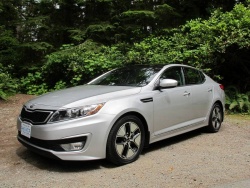 2011 Kia Optima Hybrid. Click image to enlarge |
|
Related links
Manufacturer’s web site |
Review and photos by Paul Williams
Photo Gallery:
2011 Kia Optima Hybrid
Tofino, British Columbia – One supposes that the natural splendour of Vancouver Island’s lush, green environment was seen as an obvious complement to the Kia Optima Hybrid’s eco-credentials, hence our presence in this magnificent and memorable place for the car’s introduction.
Well, why not make the connection? The natural world is our home; we want to protect it, and hybrids arguably contribute to that worthy goal. But when it comes to personal transportation, most consumers are okay with protecting the environment as long as they don’t have to compromise on price, power, appearance and utility.
Fortunately, the Optima Hybrid scores on all these parameters. At $30,595, the Optima Hybrid is aggressively priced against midsize hybrid sedan competitors from Ford, Toyota and Nissan. Standard features include push-button ignition with smart-key, UVO by Microsoft audio entertainment system, power heated front seats with memory driver’s seat, cloth/leatherettte upholstery, cooled glove-box, LED tail lights, 16-inch alloy wheels, dual-zone automatic climate control, Bluetooth connectivity, automatic headlights, LED outside mirror repeaters, fog lights and rear-view camera among a long list of other amenities and features.
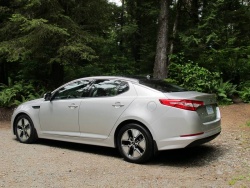 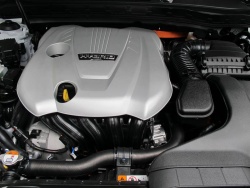 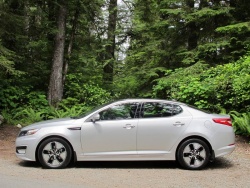 2011 Kia Optima Hybrid. Click image to enlarge |
The $35,495 Optima Hybrid Premium adds a range of features, some of which are typically only found in luxury cars. A leather interior with heated and cooled (ventilated) seats, for example, is unheard of in mainstream family sedans, as is a heatable steering wheel and heated rear seats. A navigation system is included, along with 17-inch alloy wheels, panoramic sunroof, rain-sensing windshield wipers, xenon headlights, an Infinity audio system and automatic defogging. The Optima Hybrid Premium handily out-prices and out-equips the Ford Fusion Hybrid, for example, which lists for over $40,000 without leather upholstery.
Power is also more-than-sufficient for a vehicle of this size and type. Kia’s Theta 2.4-litre four-cylinder gasoline engine is used, but has been converted to operate on an Atkinson cycle. Making 166-horsepower and 154 pound-feet of torque, the engine’s numbers jump to 206-hp and 195 lb.-ft. of torque when operating with Optima Hybrid’s 40-hp electric motor. This exceeds the equivalent output from its direct competitors, and provides acceleration from zero to 100 km/h in 9.2 seconds, which is also class leading, according to Kia.
Notably, the Optima Hybrid does not use a continuously variable (CVT) type of automatic transmission typically found in hybrids. Instead, it has a conventional, but “intelligent,” six-speed automatic transmission for a more familiar driving experience. The use of such a transmission obviates the need for Kia to develop or purchase a CVT, thus reducing costs. However this transmission does slightly increase fuel consumption, in comparison with a CVT.
The Optima Hybrid battery also deserves mention as it is a next-generation lithium-polymer type developed with Kia partner LG Chem (the company that also developed the battery for the Chevrolet Volt). A lithium-polymer battery is smaller, more energy dense and lighter than nickel-metal-hydride type used by auto manufacturers over the past decade. It also holds its charge longer, and provides more recovered kinetic energy and charging energy to move the vehicle as required, using electric drive assist more often and for a longer period of time.
When it comes to exterior and interior design, the pictures tell the story. This is a terrific-looking vehicle, not at all derivative and altogether impressive. Like Hyundai, Kia’s recent success is design-driven (arguably beginning with the Kia Soul, although that car predates the Peter Schreyer team responsible for the Optima). Personally, I think the Optima’s styling — inside and out — is a knock-out, pure and simple.
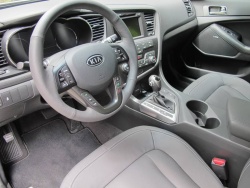 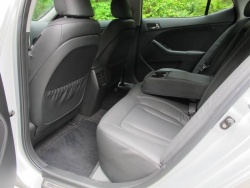 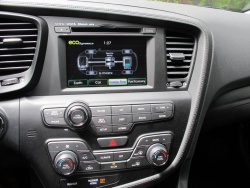 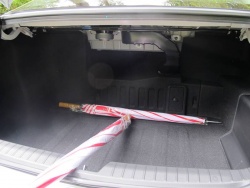 2011 Kia Optima Hybrid. Click image to enlarge |
Behind the wheel, the instrument panel, dashboard, centre-stack are of luxury-car quality in appearance and execution. Stitching in the leather seating upholstery is precise and even, the texture is rich, surfaces are pleasant to the touch and to the eye, and the interior colours tastefully complement and contrast. Granted, the dash material is leatherette, but given the price of this car, it’s all rather astonishing!
The only blemish that I could see is perhaps the navigation system (available in the Optima Hybrid Premium), which is somewhat low-rent in appearance and operation. The harsh colours of its low-resolution display, and sometimes incorrect and distracting voice guidance seemed at odds with the otherwise high quality of the interior.
And while I’m quibbling, it seems strange that the excellent and desirable UVO audio entertainment system isn’t integrated into the Optima Hybrid Premium specification. You get one or the other — UVO or Navigation — but not both. Kia seems to have its wires crossed on this, both metaphorically and probably literally.
Rear-seat room is beyond generous, and front-seat occupants are likewise treated to a spacious, comfortable cabin. Like most hybrids, though, the rear-seat doesn’t fold forward for extra cargo capacity which may be troubling for some, although it does offer a centre pass-through from the trunk. Trunk space as well is compromised given the space requirements of the battery, but this is also typical of hybrids.
On the road, and unlike other hybrids, the Kia Optima Hybrid is tuned for highway fuel economy. Kia’s research indicates that more driving is done on the highway, which is where hybrid fuel-economy tends to be weak, or at least, less remarkable.
Consequently, the Optima Hybrid is rated at 5.6/4.9 L/100 km, city/highway, combining an excellent city rating with better-than-expected highway fuel consumption. We managed 6.2 L/100 km at highway speeds in the 90-110 km/h range over approximately 400 km of driving, mostly on the mountainous highway across Vancouver Island. I used the “eco” mode, which conserves fuel when accelerating, but automatically kicks into normal mode when extra power is required.
Significantly, the Optima Hybrid’s power proved quite sufficient when ascending the steeper stretches of our route, and being able to downshift into fourth or third using the “Sport” mode was helpful when descending.
At highway speeds, the cabin is quiet and the ride is smooth but controlled. Braking is even and without the intrusive “drag” associated with some hybrids when the system switches to regenerative mode. Steering is sporty and direct, and speaking of the steering, the EPAS (Electronic Power Assist Steering) is linked to the electronic stability control in this car so that in emergency situations, the system will assist the driver to steer in the desired and required direction. Another high-end feature!
The Kia Optima Hybrid is a worthy addition to the Optima line-up, but that line-up is strong, with the base and SX turbo models also offering excellent value, styling and features. Presumably Kia doesn’t mind which one you buy.
Pricing: 2011 Kia Optima Hybrid
2011 Kia Optima Hybrid: $30,595
2011 Kia Optima Hybrid Premium: $35,495
Assembled in Hwasung, South Korea









